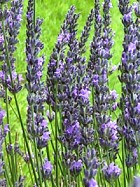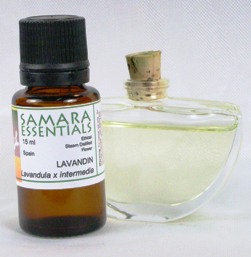
Plant Part: Flower
Extraction: Steam Distilled
Growing Practice: Ethical
Country of Origin: Spain
Odor Type: HERBACEOUS

Odor Characteristic: Very strongly herbaceous with fresh camphene-cineole topnotes and a woody-herbaceous body. It is not extremely tenacious.
Appearance: pale yellow almost colorless liquid
BioChemical Class: ester, alcohol, ketone
CAS No: 8022-15-9
About the Plant
Lavandin is a hybrid plant, developed by crossing a true lavender Lavandula officinalis with spike lavender lavandula latifolia, now widely cultivated and resulting in hundreds of varities, some more interesting than others. It is cultivated for oil production and dried or extracted botanicals in France, Hungary, Spain, Yugoslavia, Argentina and elsewhere. It is one of the tremendous success stories and was unknown until the late 1920's. The plant is larger than a typical angustifolia, aka officinalis.Perfumery: Not necessarily the best lavender for perfumery.![]()
It is now recommended that Lavandin be used with caution due to its sensitisation potential in pregnancy and lactation and because studies on the uterus in Vitro show decrease in intensity of contractions. It is extremely important to be accurately assured of the source and quality of the essential oil if used during pregnancy, childbirth or while lactating or breast feeding.
Lavender essential oil and its hybids are relatively safe to use except for the sensitisation issue. Most probably the incidence of adverse effects is due to adulteration, especially with synthetic components, rather than the essential oil itself.
The information provided on these pages is not a substitute for necessary medical care, nor intended as medical advice. Always keep aromatic extracts tightly closed and in a cool, dark place, out of reach of children. Never ingest aromatic extracts. Always dilute aromatic extracts when applying topically and avoid areas around eyes or mucous membranes. If redness or irritation occurs, stop using immediately and contact your health provider if necessary.![]()
all images and content copyright ©2000—2020 by suzumebachi design and samara botane





